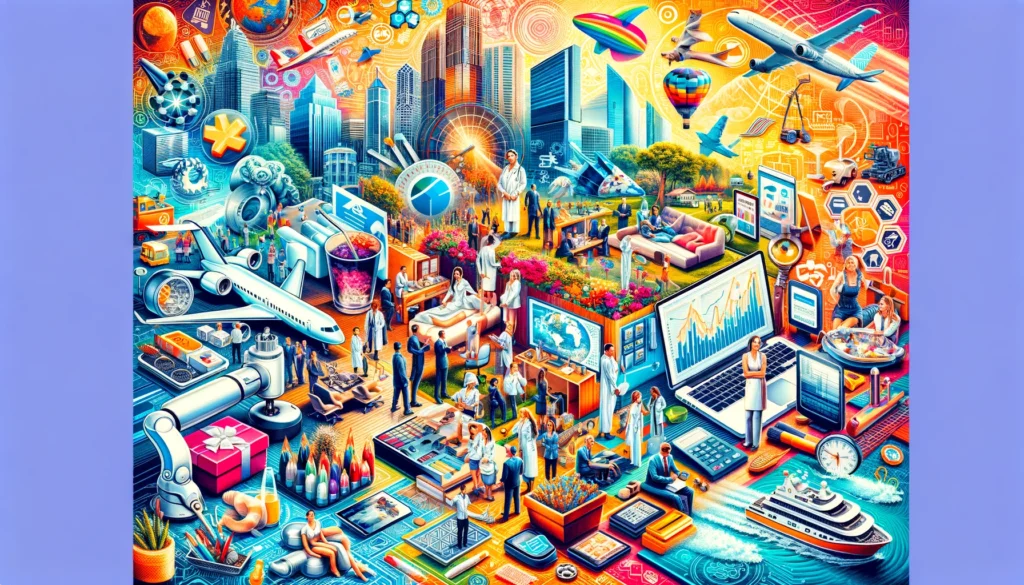Welcome to our guide on the “Top 10 Fastest Growing Industries“! In this article, we’re going to take a look at the industries that are growing the fastest right now. From healthcare to technology and beyond, we’ve got all the latest information. If you’re curious about where the job market is heading or what industries are booming, this is the perfect read for you. We’ve made sure to include lots of interesting facts and predictions, so whether you’re thinking about your career, starting a business, or just want to stay informed, you’ll find something valuable here. Let’s dive in and explore these exciting industries together!
1. Healthcare
The healthcare industry is experiencing remarkable growth and is forecasted to continue this upward trajectory. Here’s what you need to know about this booming sector:
- Job Creation: The healthcare industry is a powerhouse for job creation. The Bureau of Labor Statistics predicts approximately 1.9 million jobs opening each year within this sector. This growth is fueled by a combination of factors including an aging population, technological advancements, and a greater focus on health and wellness.
- Areas of Expansion: This industry isn’t just about doctors and nurses. Growth spans across various roles such as home health services, outpatient care centers, dental offices, and more. It also includes behind-the-scenes roles in hospital administration and health information technology.
- Revenue Growth: The financial aspect of healthcare is equally impressive. Revenue in this sector is expected to surge, with a growth rate of 14.77% projected by 2027. This translates to an increase of about $28.77 billion, indicating not just more jobs but also a greater economic impact.
- Employment Trends: In recent times, healthcare employment has risen significantly. For instance, in November 2022 alone, there was an addition of 45,000 jobs in healthcare, marking a 19% increase in the annual growth rate from the previous year.
- Challenges and Opportunities: While rising inflation may pose challenges, the healthcare industry continues to evolve. The shift towards value-based care, the integration of advanced technologies, and a focus on profitability are shaping a promising future.
2. Personal Care and Service
The Personal Care and Service industry, a sector brimming with growth and opportunities, is your second key focus.
- Job Growth: The Bureau of Labor Statistics forecasts a surge in job opportunities, with about 544,800 new positions expected over the next decade. This growth is driven by an increasing demand for personal care services, a trend that shows no signs of slowing down.
- Sector Diversity: This industry encompasses a wide array of services including beauty salons, spas, fitness centers, and counseling services. It’s a sector that caters to a variety of needs, from physical grooming to mental well-being, reflecting the diverse demands of today’s consumers.
- Revenue Projections: The revenue in the Personal Care and Service industry is projected to grow by 4.64%, reaching approximately $528.6 billion by 2027. This growth is indicative of the increasing value placed on personal care and wellness services.
- Employment Trends: Despite a slight decline in growth rate since 2020, the industry is bouncing back robustly. For example, general personal service jobs saw an addition of 11,000 positions in November, averaging 15,000 new jobs monthly for the year. Specialized roles like barbers, hairstylists, and cosmetologists are expected to see an 11% growth by 2031.
- Post-Pandemic Rebound: The industry has adapted remarkably post-pandemic, with many businesses implementing operational changes to attract more clients and create safe environments. This adaptability is key to the industry’s resilience and ongoing growth.
- A Promising Future: With an emphasis on personal well-being and self-care, the Personal Care and Service industry is more than just a trend. It’s a sector that caters to the fundamental needs of individuals, promising sustained growth and myriad opportunities for those interested in joining this vibrant field.
3. Travel, Leisure, and Hospitality
The Travel, Leisure, and Hospitality industry is a vibrant and fast-evolving sector, offering a world of opportunities. As people’s desire to explore and experience new cultures continues to grow, so does this industry. Here’s a detailed look at this exciting sector:
- Industry Growth: The industry is expected to reach a staggering $6,347.8 billion by 2027. This growth is propelled by increased disposable income and global connectivity, encouraging more people to travel and seek leisure activities.
- Diverse Opportunities: This sector encompasses a wide range of jobs, including those in arts, entertainment, historical sites, hotels, amusement parks, food service, and transportation. It’s a melting pot of opportunities for individuals with various skills and interests.
- Revenue Growth: The projected revenue growth rate is 6.7%, amounting to an increase of about $1,016 billion by 2027. This significant growth is a testament to the sector’s resilience and adaptability, especially in the wake of global challenges.
- Employment Trends: The hospitality and leisure segment has been adding an average of 82,000 jobs per month. Despite still being below pre-pandemic levels, this trend indicates a robust recovery and ample room for further growth. Specific roles, like flight attendants and pilots, are expected to see substantial growth, with flight attendant positions growing 21% and pilot jobs by 6% until 2031.
- Global Influence: The industry’s growth is not just limited to one region. For instance, Mexico is leading the solo travel market in North America, which positively impacts travel and hospitality businesses worldwide.
- The Future Outlook: As people continue to value experiences and cultural exploration, the travel, leisure, and hospitality industry is poised for continued expansion. This sector offers a dynamic and engaging career path for those passionate about creating memorable experiences for others.
4. Commercial and Residential Construction
The Commercial and Residential Construction industry is a cornerstone of economic growth, showcasing robust development and offering a multitude of opportunities. This sector reflects the changing dynamics of urbanization and lifestyle preferences. Here’s an in-depth look at what makes this industry a key player:
- Industry Drivers: Factors like low-interest rates, increased disposable income, and improved access to credit are fueling the growth of the construction industry. These elements are facilitating both residential and commercial building projects, making construction a bustling hub of activity.
- Projected Growth: The global construction industry output is expected to soar by 42% by 2030. This remarkable growth trajectory positions the construction industry as a major contributor to economic recovery post-COVID.
- Employment Trends: The industry is not just growing in revenue but also in job creation. For instance, commercial construction alone added 8,000 jobs in a single month, with an annual average of 19,000 jobs being added each month.
- Housing Market Influence: Insights from iProperty Management reveal a significant 36.8% increase in new houses being built. This surge underscores the robust demand in the residential construction sector.
- Revenue Growth: The industry’s revenue growth rate is projected at 3.89%, reaching $10.47 billion by 2025. This steady increase in revenue highlights the sector’s strong financial health and potential for investment.
- Sector Diversity: The construction industry encompasses a range of professions, from laborers and helpers to architects and project managers. This diversity allows for a variety of skill sets and career paths within the industry.
- Challenges and Opportunities: While the industry faces challenges like material costs and labor shortages, it continues to innovate and adapt, providing numerous opportunities for growth and development.
5. Manufacturing
The Manufacturing industry, a longstanding pillar of economic strength, is undergoing a significant resurgence. This revival is not just in traditional manufacturing but also in advanced, technology-driven production. Here’s a comprehensive overview of this vital sector:
- Revitalized Growth: Despite challenges, the U.S. manufacturing sector is experiencing a renaissance. Over the last decade, it has added 1.3 million jobs, and the U.S. GDP within this sector is expected to increase by more than 15% in the next ten years.
- Advanced Manufacturing: The industry is evolving beyond its traditional roots. Advanced manufacturing, incorporating cutting-edge technology and automation, is creating new, higher-paying, and technically sophisticated roles. This shift is transforming the image of manufacturing from the old perception of dark, noisy factories to modern, safe, and technology-driven workplaces.
- Employment Outlook: The manufacturing sector has seen an uptick in job growth, moving from adding 30,000 jobs per month to 34,000. This increase reflects the industry’s recovery and expansion.
- Diverse Opportunities: Manufacturing today offers a range of career opportunities. From mechanical engineers to assembly team leaders, the industry is looking for a variety of skilled professionals. These roles are not only numerous but also among the highest paid in the sector.
- Economic Impact: The sector’s expected revenue growth rate is 1.11%, reaching $7.94 trillion by 2025. This growth signifies the sector’s substantial impact on the economy.
- Future Trends: The industry is poised for continued growth, driven by innovation in areas like automation, artificial intelligence, and sustainable manufacturing practices. These trends are setting the stage for a more efficient, productive, and environmentally friendly manufacturing landscape.
6. Information Technology and Artificial Intelligence (AI)
The Information Technology and Artificial Intelligence (AI) sector stands at the forefront of innovation, reshaping how we live and work. As technology advances, this industry is experiencing unprecedented growth and transformation.
-
Explosive Growth: The IT and AI industries are not just growing; they’re booming. Employment in information technology is expected to grow by 15% by 2031, with AI’s market value projected to surge by 38% annually from its current $93.5 billion.
-
Diverse Job Roles: This sector isn’t limited to traditional IT roles. It spans a variety of positions like machine learning engineers, software developers, robotics engineers, and business intelligence developers. The diversity of roles indicates the sector’s wide-reaching impact across various industries.
-
Revenue Forecast: The revenue growth in IT and AI is large, with a projected increase of 7.10% to $1.57 billion by 2027. This growth is driven by the expanding use of technology in sectors like retail, finance, healthcare, and manufacturing.
-
Employment Trends: The Bureau of Labor Statistics predicts a 12.7% growth rate for IT and AI specialists by 2028, translating to about 37,000 open jobs in this field. This growth rate outpaces many other occupations, reflecting the industry’s critical importance.
-
Technological Advancements: The IT and AI sectors are at the cutting edge of technological innovation. Advances in machine learning, cloud computing, and cybersecurity are fueling the industry’s expansion, offering new possibilities and solutions.
-
Industry Impact: IT and AI have a transformative impact on other industries, driving efficiency, innovation, and new business models. From automating routine tasks to enabling data-driven decision-making, the influence of these technologies is far-reaching.
7. Financial Services
The Financial Services industry is a critical component of the global economy, exhibiting resilience and growth even amidst economic fluctuations. This sector encompasses a wide range of services, from banking to insurance, and is essential for both individual financial health and the broader economic system.
- Steady Growth: Despite macroeconomic challenges, the financial services sector has shown remarkable stability and growth. For instance, banks have recently achieved a 14-year high in profitability, and global revenue in this sector grew by $345 billion.
- Job Market Outlook: The industry is not just growing financially but also in terms of employment. Job opportunities in the financial sector have returned to their 2021 average, with around 12,000 new jobs added each month. By 2031, the sector is expected to grow by 10%.
- Diverse Career Opportunities: Financial services offer a variety of career paths, including roles in auditing, accounting, wealth management, and billing. This diversity allows for a range of skills and specializations, catering to different interests and expertise.
- Revenue Projections: The revenue growth rate in the financial services industry is projected at 2.47%, expected to reach $3.72 trillion by 2025. This growth rate, though modest compared to some other industries, indicates a stable and expanding sector.
- Evolving Landscape: The financial services industry is undergoing significant changes, with digitalization and fintech innovations transforming traditional practices. This evolution presents new opportunities for efficiency and customer engagement.
- Global Impact: The financial services sector has a global reach, influencing economies and businesses worldwide. Its growth and stability are crucial for economic development and investment opportunities.
8. Human Resources
Human Resources (HR) is an increasingly vital industry, pivotal to the functioning and growth of businesses in various sectors. As companies evolve and workforce dynamics change, the role of HR professionals has become more crucial than ever. Here’s what to focus on in this section:
- Industry Growth: The HR sector is expanding rapidly. The expected revenue growth rate is 12.8% from $19.38 billion by 2030, highlighting the increasing significance of HR in the modern business landscape.
- Job Market Expansion: The demand for HR professionals is on the rise. The Bureau of Labor Statistics predicts a 7% growth in HR jobs by 2031, equating to about 16,300 new jobs opening each year. This growth is partly due to the need to replace retiring workers.
- Diverse Roles and Responsibilities: The HR industry offers a range of roles, from HR managers and specialists to training and development officers. These professionals handle various aspects like employee benefits, company policy updates, coordination of health insurance plans, and fostering ethical company cultures.
- Importance in Business Strategy: HR is no longer just about hiring and payroll; it plays a strategic role in shaping company culture, ensuring compliance, managing talent, and driving organizational performance.
- Technological Integration: The integration of technology in HR practices, such as the use of HR Information Systems (HRIS) and analytics, is transforming how HR departments operate, making them more efficient and data-driven.
- Global Reach: As businesses expand globally, the role of HR in managing diverse and remote workforces has become more complex and vital, emphasizing the need for skilled HR professionals.
9. Architecture
Architecture, a blend of art, science, and technology, is an industry that shapes the very spaces we live and work in. As urbanization increases and the demand for innovative design grows, this field is experiencing significant evolution and expansion.
- Industry Dynamics: The architecture industry is being influenced by rapid urbanization and a rising interest in affordable housing. This is driving growth in architectural services, expected to expand at a rate of 7.4% from $344.9 billion by 2030.
- Revenue Growth: The industry’s revenue growth rate stands at 3.6% from $55.6 billion. This steady increase underscores the ongoing demand for architectural expertise in both residential and commercial construction.
- Employment Trends: Job opportunities in architecture are expected to grow by 3% until 2031, with an average of 9,100 new jobs added each year. This growth is partly due to the need for replacements as current professionals transition or retire.
- Technological Advancements: The use of technology, like computer-aided design tools, is transforming the field, making some roles like landscape architects less in demand, while others, such as urban planners and building inspectors, are growing.
- Diverse Roles: The industry offers a variety of roles, from designing residential homes to planning entire urban districts. This diversity allows architects to specialize in different areas according to their interests and skills.
- Global Influence: Architecture is not just about creating buildings; it’s about shaping communities and influencing how people interact with their environments. As such, architects play a crucial role in addressing global challenges like sustainability and urbanization.
10. Post-Construction Finishing Trades
Post-Construction Finishing Trades, a critical segment in the building process, encompasses the final touches that transform a structure into a functional and aesthetically pleasing space. This sector is experiencing significant growth, driven by the increasing construction of residential and commercial buildings. Here’s an overview of this vital industry:
- Sector Significance: Post-construction finishing trades include essential services like drywalling, painting, flooring, and carpentry. These trades are crucial for the completion, repair, and renovation of buildings, contributing to both the functionality and aesthetic appeal of a structure.
- Market Growth: The overall market size for post-construction finishing trades is expected to reach $2,112.71 billion by 2026. This robust growth is a direct result of the ongoing construction boom in both residential and commercial sectors.
- Revenue Projections: Different sub-trades within this sector have their own growth projections. For example, the revenue growth rate for carpenters is expected to be 0.4% from $41.2 billion, electricians 1.6% from $225.4 billion, and painters 3.8% from $18.6 billion.
- Employment Trends: The job market in this field is set to expand, with an expected increase of 11.7% through 2026. This growth reflects the high demand for skilled tradespeople in finishing work.
- Diversity of Skills: The industry requires a range of specialized skills, from precise carpentry to intricate painting techniques. This diversity allows for various career paths and opportunities for skilled tradespeople.
- Industry Challenges: While the sector is growing, it faces challenges like the need for skilled labor and adapting to new materials and technologies. However, these challenges also create opportunities for innovation and specialization.
- Economic Impact: Post-construction finishing trades play a significant role in the overall economy. They not only add value to construction projects but also provide employment opportunities and contribute to the local economy.
As we wrap up our journey through the “Top 10 Fastest Growing Industries,” it’s clear that each sector is brimming with opportunities and innovations that are shaping our world in extraordinary ways. From the meticulous craftsmanship in Post-Construction Finishing Trades to the cutting-edge advancements in Information Technology and AI, these industries are not just driving economic growth; they’re crafting the future. Whether you’re a curious reader, a budding professional, or an aspiring entrepreneur, we hope this exploration has sparked your imagination and offered insights into the vibrant landscape of opportunities that await. So, as you step forward, keep these industries in mind – they are the fertile grounds where tomorrow’s dreams are taking root today. Here’s to a future as bright and promising as the sectors we’ve explored together!











